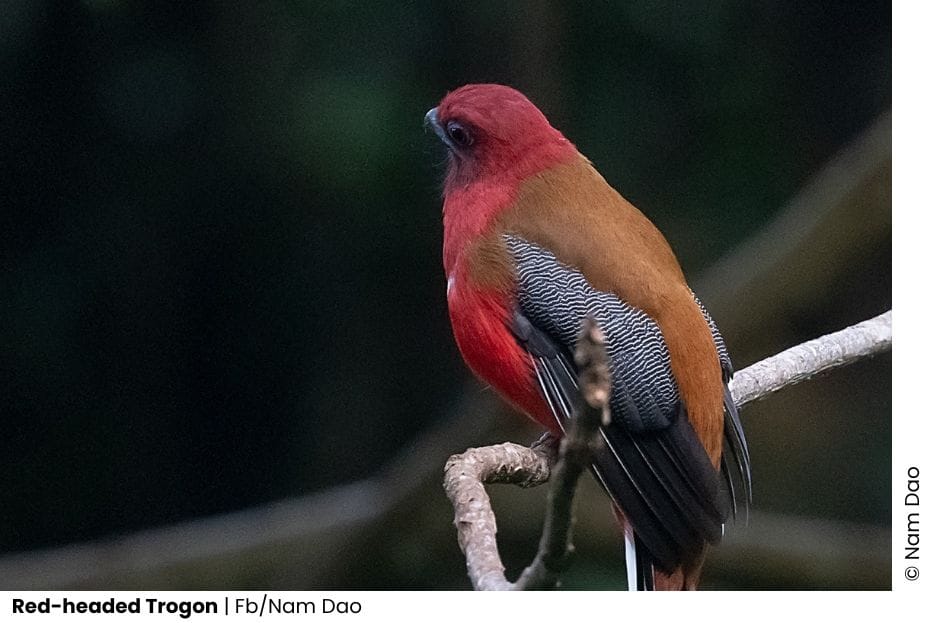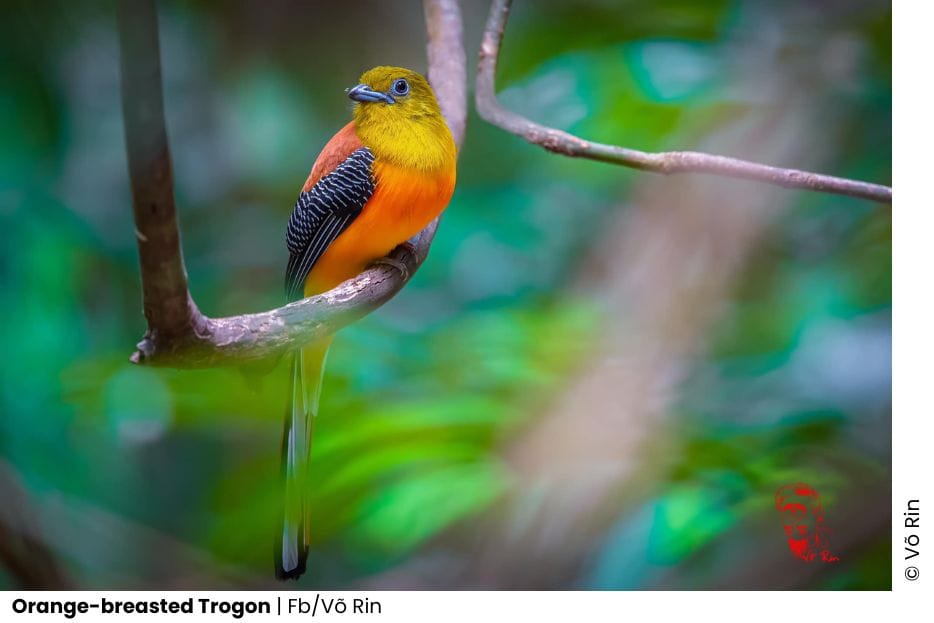Trogons of Vietnam – Trogonidae
With 3 species Trogons of Vietnam, although they are one of the fewest families of species, all of them have the beauty that birders may catalog most wanted to fill in their bird list.
You may know: Mention Vietnam to anyone who has spent time birding in the country or is perhaps planning a birding trip to Vietnam in the future and the names of two particular bird families will surely come up, pittas and laughing thrushes for a little harder Trogons might be the best bird you want to see.
The overview of Trogons families
The Trogons and quetzals are birds in the order Trogoniformes /troʊˈɡɒnɪfɔːrmiːz/ which contains only one family, the Trogonidae. The family Trogonidae contains 46 species in seven genera. The fossil record of the Trogons dates back 49 million years to the Early Eocene. They might constitute a member of the basal radiation of the order Coraciiformes and order Passeriformes or be closely related to mousebirds and Owls. The word Trogon is Greek for “nibbling” and refers to the fact that these birds gnaw holes in trees to make their nests.
Trogons are residents of tropical forests worldwide. They often sit midway up trees, often well below the canopy level, in areas that afford numerous perches from which they sally while foraging. The greatest diversity is in the Neotropics, where four genera, containing 24 species, occur. The genus Apaloderma contains three African species. The genera Harpactes and Apalharpactes, containing twelve species, are found in Southeast Asia.
Trogons feed on insects, fruit, small vertebrates, and invertebrates and their broad bills and weak legs reflect their diet and arboreal habits. Although their flight is fast, they are reluctant to fly any distance. They are generally not migratory, although some species undertake partial local movements. Trogons have soft, often colorful, feathers with distinctive male and female plumage. They are the only type of animal with a heterodactyl toe arrangement.
They nest in holes dug into trees or termite nests, laying 2–4 white or pastel-colored eggs from which altricial chicks hatch after an incubation period of 15 to 19 days. Males and females share in parental care, from incubation on. Brooded attentively by the parents for the first week or so, the chicks develop for 16 to 30 days before they fledge and leave the nest.
Are you looking for Wildlife Tours in Vietnam?
WANEE VIETNAM is your go-to destination for "Wildlife Tours in Vietnam", specializing in Birding, Primate Watching, Herping, Photography Tours and Educational Tours led by our expert guides.Trogons of Vietnam Highlight note

Red-headed Trogon Harpactes erythrocephalus
Status: Common resident
Best time to watch & Photo: Feb-Apr
Tour cover: Central & Northern
Hotspot: Cuc Phuong, Ba Vi, Ba Be

Orange-breasted Trogon Harpactes oreskios
Status: Uncommon resident
Best time to watch & Photo: Feb-Apr
Tours: South-East & Central
Hotspot: Cat Tien, Tan Phu, Da Lat
Ward’s Trogon Harpactes wardi
Status: Rare Local North-West Resident
Best time to watch & Photo: Feb-Apr
Tours: North-West
Hotspot: SaPa – Fansipan Moutain
Crocodile Trail – The Best Birding Trail in Cat Tien National Park
If you’re a birder or nature photographer planning a trip to Vietnam, few places offer [...]
Cong Troi Trail – Top 1 Dalat Plateau Birding Trail Experience
If you’re a birder or nature photographer planning a trip to Vietnam’s Central Highlands, the [...]
How to Identify the Greater Sand Plover, Tibetan Sand Plover and Siberian Sand Plover
ContentsTrogons of Vietnam – TrogonidaeTrogons of Vietnam Highlight noteAll Vietnam Birds FamiliesIdentification Differences within the [...]
Highlights of Cat Tien National Park Reptiles and Amphibian Endemics
Spanning over 71,350 hectares of tropical forests, grasslands, and wetlands, Cat Tien National Park is [...]
Highlights of Cat Tien National Park Mammals in a World Biosphere Reserve
In addition to reptiles and birds, Cat Tien National Park is also rich in mammals, [...]
Kontum Plateau Endemic and Highlight bird
Kontum Plateau Endemic And Highlight Bird species like Chestnut-eared Laughingthrush and top birding routes while [...]